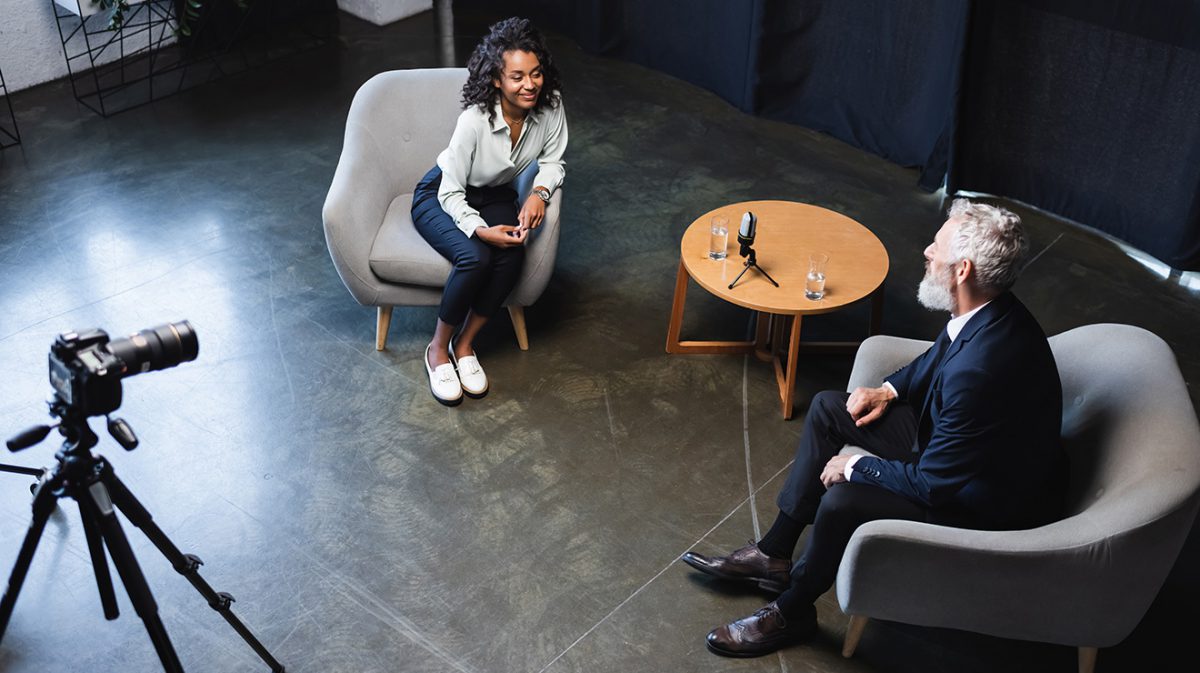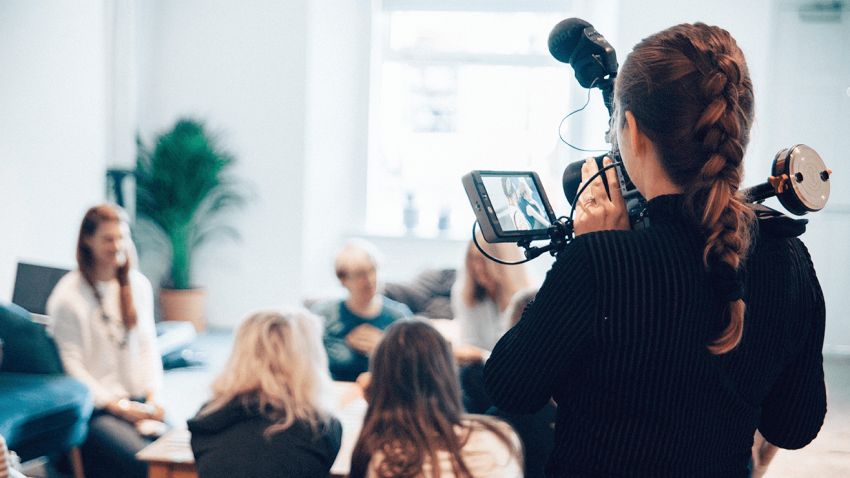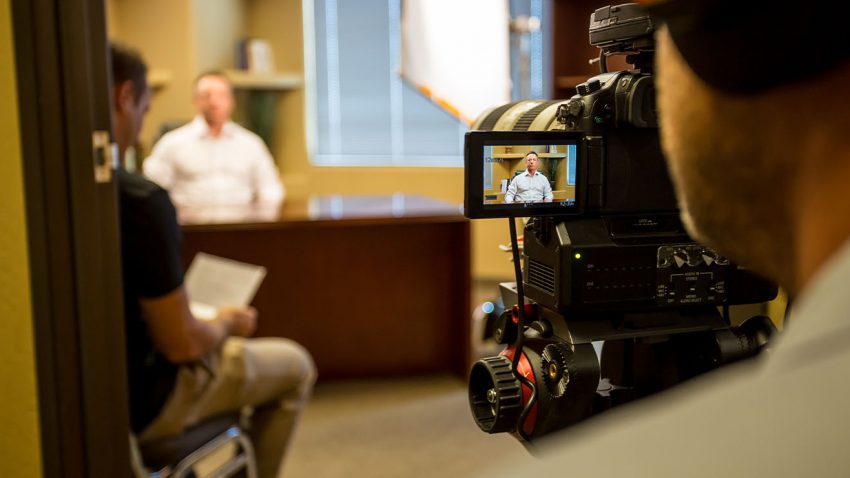(PHOTO CREDIT: LightField Studios/SHUTTERSTOCK)
Sometimes interview videos don’t work out the way you expected. There might be inclement weather, or someone got sick. Maybe the lighting is terrible or someone forgot the “hero” prop. Or maybe you start editing the footage and think, “Wow, this is one boring interview.”
We can’t do anything about Mother Nature or forgetful crews. But we can certainly talk about things you can do to produce interviews people actually want to watch. And it all comes back to the basics: Location, lighting, audio, framing, and B-roll.
Throughout this post, we’ll be examining each of these basics aspects of filming to help you improve your next interview video. (And no, you won’t need to hypnotize anyone in order to get them to watch.)
Back to the Filmmaking Basics
It’s rare for a video shoot to go absolutely perfectly. But no matter what the challenge is, it’s the filmmaker’s job to pick up the pieces and make something a client, manager, or customer will enjoy watching.
That’s especially true when it comes to interviews. You can control the lighting and atmosphere (more on that in a bit), and you can use your natural charms to make your subject comfortable and encourage better answers from them. But that’s only a start.
Think about the best interview you’ve ever seen. If you sat and watched the untouched footage, there’s a pretty good chance you wouldn’t last 5 minutes into the video.
It’s all too easy to lose interest when a project isn’t the most exciting to shoot and edit. And when that happens, we often fall back on habits, like the things we learned in Videography 101.
So yes, everything on that list might feel like an elementary part of filmmaking. But sometimes building blocks are the things we take for granted. All you need is a simple trick to get new ideas. And what could be simpler than modified versions of the oldest tricks in the book?
Don’t Obsess About the Location
One of the biggest complaints about interviews is where they’re shot. In most cases, you’ll be in an office space. But your locations might vary; they might feel like a cold and grim hospital room, or an abandoned downtown loft.
If you fixate on the challenges of the location, you could overcorrect or, worse, you might give up on trying to deal with it and slap a bandaid on it in post-production.
This is where the “lemons out of lemonade” idea comes into play. And set design is going to be your favorite lemon to use, because it gives you at least a little creative control.
Is the space a little too busy? Find anything not nailed down and move it. Is it too empty? Beg, borrow, or steal props from any other room you can access. You use lighting or white balance to create a tone or guide the viewer’s eye, but you still need to establish visual interest in the very first frames of the video.
The unfortunate thing is that you won’t always have the opportunity to scout a location and choose it beforehand. That’s why you want to focus on finding a good spot as soon as you arrive on set for a project.
… But Do Obsess About the Lighting
If you’re working with a client, lighting is the hill you should choose to die on (if you have to). It’s not always easy to explain the concept to someone, but how you light a scene literally sets the tone of the entire production.
The good news is you don’t need thousands of dollars of equipment to have a good interview lighting setup. But you will want to use the tools you do have, whether that’s your own gear, or nearby windows, or your DIY diffusers.
Take advantage of natural lighting when possible. If you can’t get a location with nice windows, use your own lighting to recreate a natural vibe.
Here’s an extra tip: By placing your lights outside the windows, you can get ahead of the clock before the weather or lighting changes. The set gets to keep its natural look, and you don’t have to deal with a hundred adjustments if the sky becomes overcast or midmorning becomes midafternoon.
Plan to Deal With Audio Early
When you’re heading to scout a location (or taking stock of the situation when you arrive to shoot), you’ll want to pay attention to the audio as well as the visuals. Nothing’s worse than shooting an entire interview, starting to edit the footage, and discovering an awful A/C unit humming along in the background.
You can do a lot of magic to clean up footage, and you should always have a backup mic to capture audio. But if you don’t check for ambient sounds, you run the risk of ruining all the hard work you did to transform the client’s cube farm into a swanky penthouse.
There are dozens of resources out there to help point you on the right track, from choosing the right microphone for the project to capturing better audio in less-than-ideal circumstances. Audio is a related but still different artform, and the more attention you pay to it, the better the final product will be.
Frame Each Angle With Care
Once again, make sure you’re taking advantage of the effort you put into the previous topics.
The cool view from a distant window or the weird lamp behind a couch provides visual depth; that sort of thing matters when you’re setting the scene and adding some visual interest. But if you’re not framing your subject front and center, the viewer won’t appreciate any of the background…because they won’t be paying attention anymore.
Sure, people will appreciate the cinematic qualities of your set. Just don’t forget that they’re watching the interview to hear what the interviewee has to say — not to appreciate your clever production design.
There’s a reason framing is often a thing we associate with our favorite filmmakers and directors. Applying similar concepts to interview videos is an easy way to elevate the entire project.
Capture More B-roll Than You Need
Knowing how to conduct a video interview is something that comes with time. But even if you’re not the best conversationalist, you can pair the subject’s answers with b-roll footage that establishes the idea and emotions even if their answers don’t clearly state them.
There’s a saying that you can never know which angle you needed until the shoot is over.
So, just get every shot you can. It might add a little time to post-production, but that’s a better problem to deal with than getting compelling interview content with no b-roll visuals to match it.
Why People Love Interview Videos
Our cultural obsession with interviews is a strange thing. People will spend hours each week listening to podcast interviews, or watch every interview that features their favorite social media personalities.
For a civilization that (as a general rule of thumb) can’t wait to get out of school, we’re all happy to learn from expert or entertaining voices. Think about the importance of TED Talks, or talk shows on YouTube, or the rise of educators on Twitch.
We love discovering new things and hearing stories, and interview videos combine information and emotion with visual elements that help tell people’s stories. So even if your next project or client job seems like it could be a nap-inducing interview, think of it as a challenge that you can transform into a piece that could inspire or change someone’s life.
There aren’t many better “calls to action” for a filmmaker than that, huh?








